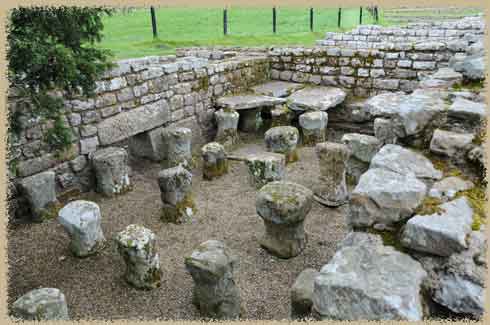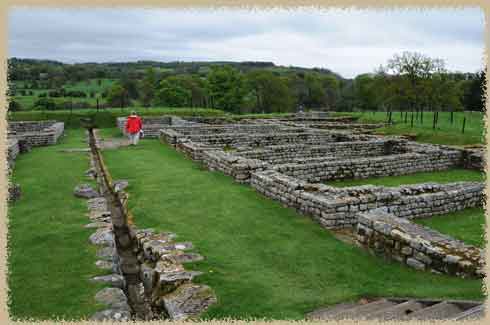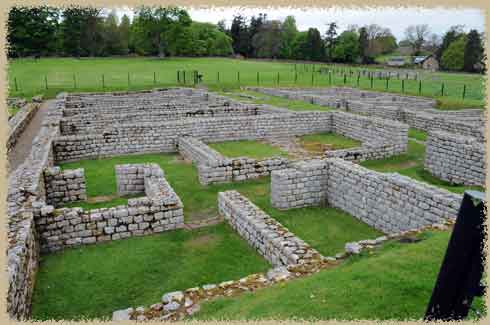Chester Fort
If you are at all interested in Roman ruins, this is a stop you don't wnat to miss.

the under-floor support in what might have been the bathhouse
2nd Century Roman Fort
We dipped down to follow Hadrian's Wall for a bit, and visited several of the mileforts and larger Roman settlements along the way. Of course, we picked the rainiest day we had in Scotland to do it, but the misty day actually added quite a bit to the experience, if you ask me.
This is a large fort, built just after the completion of Hadrian's Wall in 123 CE, and it is an incredibly well-preserved cavalry fort. It was reached via a wide stone bridge (long gone), across the River Tyne. If you walk down near the existing bathhouse, you can see the stone footings for the bridge on the far shore. The fort was primary to defend this easy crossing of the Tyne, the first real "gap" in Hadrian's wall as it crosses Scotland.
On the site are barracks, a bathhouse, streets, drainage, supply depots, and a variety of other buildings. It's surprising that many exist at all, of course - in the early 1800s, the owner of the nearby CHester's House estate 'landscaped over' the ruins here, to give himself a smooth, uninterrupted grassy park for his new home. He retreived a number of artefacts, but in general just wanted to cover up the eyesore and have a lovely green slope to the water. Luckly, his son re-excavated the fort and established the first museum here on the site - housed in a lovely victorian building with glass cases and little inscribed labels.

barracks and officer's quarters (and a once-covered sewer
The fort is quite large, about 5 3/4 acres and walled in with 5'-thick walls, backed by a rampart and fronted by a ditch. It was defended by four stone towers at each corner and eight more that studded the sides of the rectangular fort. .The ramparts and walls were built specifically to merge with the wall.
All six gateways remain in the walls, and a small section of the wall still interects the outer fortifications.

reconstruction of the walls ofthe headquarters building
The headquartesr building it he most impressive of the stone remains on the site, but the real draw of the site is the bathhouse and North Tyne Bridge, I think. The bridge would have spanned about 190 feet across the river from thick stone buttresses on either shore. Nearby, the bathhouse is in remarkable condition; you can walk through the different rooms (cool, warm, hot), and see the dressing rooms and rows of lockers, and view the stone flues and piping that warmed the floor and the water.
Walking down the hill to the baths and entering what appears to be the reception hall and dressing rooms is a very familiar sensation -- walk into any locker room and you see the same thing; benches and shelves for your things. From there, visitors to the bath would enter the various pools - first being oiled and strigiled by a slave before entering the hot baths and then the sucessively cooler ones, or a sauna. All th erooms were heated by fires underneath the floor, which wafted heated air under the stones and through various spaces in the building. It must have been a very comfortable place, te soldiers in this cold, northerly climate must have loved being able to get a taste of home


